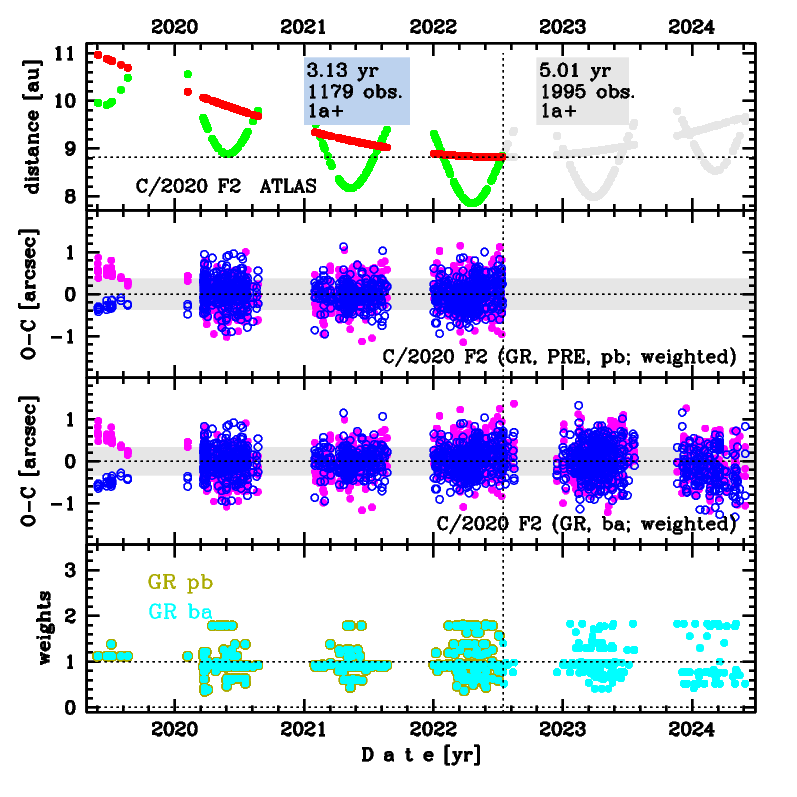C/2020 F2 ATLAS
more info
Comet C/2020 F2 was discovered on 21 March 2020, more than three years before its perihelion passage. Later a series of pre-discovery observations were found going back to 27 May 2019 (heliocentric disctance: 10.96 au). This comet was observed until 30 May 2024 (as in February 2025).
Comet had its closest approach to the Earth on 19 April 2022 (7.85 au); about three months before its perihelion passage.
The preferred GR solution given here is based on data span over 5.01 yr in a range of heliocentric distances: 10.96 au – 8.82 au (perihelion) – 9.66 au.
This Oort spike comet suffers tiny planetary perturbations during its passage through the planetary system that lead to a bit less tight future orbit inside the Oort spike zone (see future barycentric orbits).
Comet had its closest approach to the Earth on 19 April 2022 (7.85 au); about three months before its perihelion passage.
The preferred GR solution given here is based on data span over 5.01 yr in a range of heliocentric distances: 10.96 au – 8.82 au (perihelion) – 9.66 au.
This Oort spike comet suffers tiny planetary perturbations during its passage through the planetary system that lead to a bit less tight future orbit inside the Oort spike zone (see future barycentric orbits).
| solution description | ||
|---|---|---|
| number of observations | 1995 | |
| data interval | 2019 05 27 – 2024 05 30 | |
| data type | perihelion within the observation arc (FULL) | |
| data arc selection | entire data set (STD) | |
| range of heliocentric distances | 10.96 au – 8.82 au (perihelion) – 9.66 au | |
| detectability of NG effects in the comet's motion | NG effects not determinable | |
| type of model of motion | GR - gravitational orbit | |
| data weighting | YES | |
| number of residuals | 3950 | |
| RMS [arcseconds] | 0.34 | |
| orbit quality class | 1a+ | |
| orbital elements (heliocentric ecliptic J2000) | ||
|---|---|---|
| Epoch | 2022 08 09 | |
| perihelion date | 2022 07 15.61461280 | ± 0.00054765 |
| perihelion distance [au] | 8.81709895 | ± 0.00000361 |
| eccentricity | 1.00524387 | ± 0.00000272 |
| argument of perihelion [°] | 48.352932 | ± 0.000031 |
| ascending node [°] | 250.274951 | ± 0.000014 |
| inclination [°] | 163.585563 | ± 0.000004 |
| reciprocal semi-major axis [10-6 au-1] | -594.74 | ± 0.31 |

Upper panel: Time distribution of positional observations with corresponding heliocentric (red curve) and geocentric (green curve) distance at which they were taken. The horizontal dotted line shows the perihelion distance for a given comet whereas vertical dotted line — the moment of perihelion passage.
Middle panel(s): O-C diagram for a given solution (sometimes in comparison to another solution available in CODE), where residuals in right ascension are shown using magenta dots and in declination by blue open circles.
Lowest panel: Relative weights for a given data set(s).
Middle panel(s): O-C diagram for a given solution (sometimes in comparison to another solution available in CODE), where residuals in right ascension are shown using magenta dots and in declination by blue open circles.
Lowest panel: Relative weights for a given data set(s).